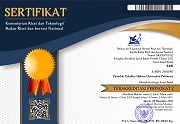Analysis of The Application of Deradicalization And Constraints And Obstacles: A Case Study of Bandung Suicide Bombing
 )
)
(1) Faculty of Law Bhayangkara University Jakarta Raya, Jakarta, Indonesia
 Corresponding Author
Corresponding Author
Abstract
Introduction: The concept of deradicalization itself has been running for the first time since 2005 but there is no guide or patent concept for this program. The effect given through the deradicalization program must be recognized is not optimal, but this does not necessarily make deradicalization a failed innovation, keep in mind that the existence of the deradicalization program is an answer to the handling of terrorism that is considered hard and intimidative (hard approach), while the more subtle ways of dialogue and religious approach (soft approach) is considered also able to neutralize the values of terrorism in someone who is already radical.
Purposes of the Research: The real purpose of de-radicalization in general is to prevent repeated terror incidents by former prisoners, because the National Police itself has the task of being able to detect and prevent acts of violence that insurgents.
Methods of the Research: The research method used is normative legal research with a statute legal approach and a conceptual approach
Results of the Research: The deradicalization Program is not a program that can be assessed directly as a failed program, deradicalization must be remembered as a reflection of the bad and hard handling (hard approach) so that the form of humanism and respect for human rights can actually be reflected by the existence of deradicalization, with the existence of deradicalization also illustrates that the perpetrators of terror or ex-prisoners have hope to return to normal life, also indicates that the government pays attention to those who commit this crime.Keywords
DOI
10.47268/sasi.v29i2.1333
Published
2023-04-19
How To Cite
@article{SASI1333,
author = {Edi Hasibuan},
title = {Analysis of The Application of Deradicalization And Constraints And Obstacles: A Case Study of Bandung Suicide Bombing},
journal = {SASI},
volume = {29},
number = {2},
year = {2023},
keywords = {Deradicalization; Obstacles; Terror},
abstract = {Introduction: The concept of deradicalization itself has been running for the first time since 2005 but there is no guide or patent concept for this program. The effect given through the deradicalization program must be recognized is not optimal, but this does not necessarily make deradicalization a failed innovation, keep in mind that the existence of the deradicalization program is an answer to the handling of terrorism that is considered hard and intimidative (hard approach), while the more subtle ways of dialogue and religious approach (soft approach) is considered also able to neutralize the values of terrorism in someone who is already radical.Purposes of the Research: The real purpose of de-radicalization in general is to prevent repeated terror incidents by former prisoners, because the National Police itself has the task of being able to detect and prevent acts of violence that insurgents. Methods of the Research: The research method used is normative legal research with a statute legal approach and a conceptual approachResults of the Research: The deradicalization Program is not a program that can be assessed directly as a failed program, deradicalization must be remembered as a reflection of the bad and hard handling (hard approach) so that the form of humanism and respect for human rights can actually be reflected by the existence of deradicalization, with the existence of deradicalization also illustrates that the perpetrators of terror or ex-prisoners have hope to return to normal life, also indicates that the government pays attention to those who commit this crime.},
issn = {2614-2961}, pages = {277--285} doi = {10.47268/sasi.v29i2.1333},
url = {https://fhukum.unpatti.ac.id/jurnal/sasi/article/view/1333}
}
Journal Article
Ahnad Maulana dkk, Atas Nama Jihad : Konstruksi Pemikiran Radikalisme dan Terorisme, At-Tabbayun, 1 no 1 (2022): 42-45.
Arif Hidayat, Laga Sugiarto,Starategi Penangkalan dan Penanggulangan Radikalisme Melaui Cultural Reinforcement Masyarakat Jawa Tengah, Jurnal USM Law Review 3 no 1 (2020): 147-150
Arief Rifkiawan Hamzah, Radikalisme dan Toleransi Berbasis Islam Nusantara, Sosiologi Reflektif, Pascasarjana UIN Sunan Kalijaga Yogyakarta, 13 no 1 (2018): 23.
Frisca Alexandra, Anlsisis Kajian Terorisme dan Radikalisme Dalam 3 Persepektif Teoritis, Jurnal Paradiqma, 6 no 3, (2017), 137.
Imran Tahir, M. Irwan Tahir, Perkembangan Pemahaman Radikalisme Di Indonesia, Jurnal Ilmiah Administrasi Pemerintah Daerah 12 no 2 (2020): 75.
M. Nuh, Faktor-Faktor Penyebab Munculnya Faham/ Gerakan Islam Radikal di Indonesia, HARMONI Jurnal Multikultural & Multireligius VIII (2009): 36
Muhammad Mustofa, Memahami Terorisme: Suatu Prespektif
Kriminologi, Jurnal Kriminologi Indonesia, 2 no 3 (2002): 31.
Muhammad Najib Azca, Yang Muda Yang Radikal, MAARIF Institute for Culture and Humanity 8 no 1 (2013): 18
Petrus R Golose, “Deradikalisasi Terorisme, Humanis, Soul Approach dan Menyentuh Akar Rumput”, (Jakarta: Yayasan Pengembangan Kajian Ilmu Kepolisian, 2009): 62-63.
Ray Adhari Jajuri, Rahmat, Analisis Kebijakan Counter Radikalisme Melalui Forum Kerukunan Umat Beragam, Jurnal Civil Hukum 6 no 2 (2021): 164-167.
Ria Angin, Membangun Kesadaran Kritis Generasi Muda dari Radikalisme dan Terorisme yang Mendorong NKRI, Jurnal Penngabdian Masyarakat IPTE, 4 no 2 (2018): 124-127.
Saifudin Asrori, Mengikuti Panggilan Jihad Argumentasi Radikalisme dan Ekstremisme di Indonesia, Jurnal Aqlam, 4 no (1) 2019: 119-125 .
Book
Andrew Silke,“Prisons, Terrorism and Extremism “Critical Issues in Management, Radicalisation, and Reform” New York: Routhledge, 2014.
M. Tito Karnavian, “Indonesian Top Secret: Membongkar Konflik Poso”, Jakarta: Gramedia, 2008.
Thesis, Web Page, and Others
Adhe Surya Bakti,”Peta Pelaku Bom Thamrin” Makalah dalam Forum Disccusion Group “Isis dan Gerakan dan Jaringan teroris Baru”, Pakar (Pusat Kajian Terorisme), Jakarta, 2016 hasil penelitian sosial menyebutkan bahwa Sunakim dan Juhanda para pelaku bom Samarinda pada tahun 2016 merupakan contoh kegagalan deradikalisasi di dalam penjara. Keduanya justru menjadi lebih radikal dan kembali melakukan aksi terorisme setelah keluar dari penjara
BNPT, “Blueprint Deradikalisasi”, Jakarta, 2013.
BNPT dalam Rakornas Pencegahan Terorisme dapat dilihat dalam Republika https://www.republika.co.id/berita/qlmk6y291/survei-potensi-radikalisme-di-indonesia-menurun
https://nasional.kompas.com/read/2011/10/05/15592674/Survei. Indonesia. Masih. Rentan. Aksi. Radikalism e?1
Kompas dalam https://nasional.kompas.com/read/2021/09/15/16283361/teroris-manfaatkan-kotak- amal-bnpt-kita-perlu-waspada-kepada-siapa-kita-beri
Kompas, dalam https://nasional.kompas.com/read/2022/12/07/14460041/aksi-terorisme-marak- terjadi-jelang-natal-dan-tahun-baru-mengapa
Kompas, dalam https://www.kompas.com/tren/read/2022/12/08/120000965/bom-bunuh-diri-mapolsek- astanaanyar-pelaku-eks-napiter-nusakambangan?source=widgetML&engine=V
Pengamat Intelijen dan Militer Susaningtyas Kertopati dalam Kompas https://rm.id/baca- berita/nasional/72522/ini-saran-pakar-agar-program-deradikalisasi-bnpt-efektif .
Republika, dalam https://www.republika.co.id/berita/r21lpq396/pendana-bom-bunuh-diri-mapolresta- .
Reeza Andi Nova, “Kajian Implementasi Undang-undang No.5 Tahun 2018 tentang Tindak Pidana Terorisme (Studi Kasus Deradikalisasi Detasemen Khusus 88 AT Polri)”, Tesis, Jakarta: Universitas Indonesia, 2022
Cited-By:
1. The repatriation of returning ISIS foreign terrorist fighters: Analysis of the factors influencing Indonesia’s refusal and its implications on counterterrorism efforts
Muhammad Anns, Muhamad Syauqillah
Masyarakat, Kebudayaan dan Politik vol: 36 issue: 4 first page: 475 year: 2023
Type: Journal [View Source]
| Dublin Core | PKP Metadata Items | Metadata for this Document | |
| 1. | Title | Title of document | Analysis of The Application of Deradicalization And Constraints And Obstacles: A Case Study of Bandung Suicide Bombing |
| 2. | Creator | Author's name, affiliation, country | Edi Saputra Hasibuan; Faculty of Law Bhayangkara University Jakarta Raya, Jakarta; Indonesia |
| 3. | Subject | Discipline(s) | |
| 3. | Subject | Keyword(s) | Deradicalization; Obstacles; Terror |
| 4. | Description | Abstract | Introduction: The concept of deradicalization itself has been running for the first time since 2005 but there is no guide or patent concept for this program. The effect given through the deradicalization program must be recognized is not optimal, but this does not necessarily make deradicalization a failed innovation, keep in mind that the existence of the deradicalization program is an answer to the handling of terrorism that is considered hard and intimidative (hard approach), while the more subtle ways of dialogue and religious approach (soft approach) is considered also able to neutralize the values of terrorism in someone who is already radical.Purposes of the Research: The real purpose of de-radicalization in general is to prevent repeated terror incidents by former prisoners, because the National Police itself has the task of being able to detect and prevent acts of violence that insurgents. Methods of the Research: The research method used is normative legal research with a statute legal approach and a conceptual approachResults of the Research: The deradicalization Program is not a program that can be assessed directly as a failed program, deradicalization must be remembered as a reflection of the bad and hard handling (hard approach) so that the form of humanism and respect for human rights can actually be reflected by the existence of deradicalization, with the existence of deradicalization also illustrates that the perpetrators of terror or ex-prisoners have hope to return to normal life, also indicates that the government pays attention to those who commit this crime. |
| 5. | Publisher | Organizing agency, location | Faculty of Law, Universitas Pattimura |
| 6. | Contributor | Sponsor(s) | Faculty of Law Bhayangkara University Jakarta Raya |
| 7. | Date | (YYYY-MM-DD) | 2023-04-19 |
| 8. | Type | Status & genre | Peer-reviewed Article |
| 8. | Type | Type | |
| 9. | Format | File format | |
| 10. | Identifier | Uniform Resource Identifier | https://fhukum.unpatti.ac.id/jurnal/sasi/article/view/1333 |
| 10. | Identifier | Digital Object Identifier | 10.47268/sasi.v29i2.1333 |
| 11. | Source | Title; vol., no. (year) | SASI; Volume 29 Issue 2, June 2023 |
| 12. | Language | English=en | en |
| 13. | Relation | Supp. Files |
Untitled (241KB) Untitled (241KB) |
| 14. | Coverage | Geo-spatial location, chronological period, research sample (gender, age, etc.) | |
| 15. | Rights | Copyright and permissions | Copyright: Authors who publish their manuscripts in this Journal agree to the following conditions: 1. The copyright in each article belongs to the author, as well as the right to patent. 2. Authors can enter into separate, additional contractual arrangements for the non-exclusive distribution of the journal's published version of the work (e.g., post it to an institutional repository or publish it in a book), with an acknowledgment of its initial publication in this journal. 3. Authors are permitted and encouraged to post their work online (e.g., in institutional repositories or on their website) before and during the submission process, as it can lead to productive exchanges, as well as earlier and greater citation of published work. 4. Authors have the right to self-archiving of the article (Author Self-Archiving Policy)
License: The SASI Journal is disseminated based on the Creative Commons Attribution-NonCommercial 4.0 International license terms. This license allows anyone to copy and redistribute this material in any form or format, compose, modify, and make derivatives of this material for any purpose. You cannot use this material for commercial purposes. You must specify an appropriate name, include a link to the license, and certify that any changes have been made. You can do this in a way that is appropriate but does not imply that the licensor supports you or your use.
|
Copyright (c) 2023 Edi Saputra Hasibuan

This work is licensed under a Creative Commons Attribution-NonCommercial 4.0 International License.
Cited-By:
1. The repatriation of returning ISIS foreign terrorist fighters: Analysis of the factors influencing Indonesia’s refusal and its implications on counterterrorism efforts
Muhammad Anns, Muhamad Syauqillah
Masyarakat, Kebudayaan dan Politik vol: 36 issue: 4 first page: 475 year: 2023
Type: Journal [View Source]

 : 2662 times
: 2662 times Download : 1143 times
Download : 1143 times
















